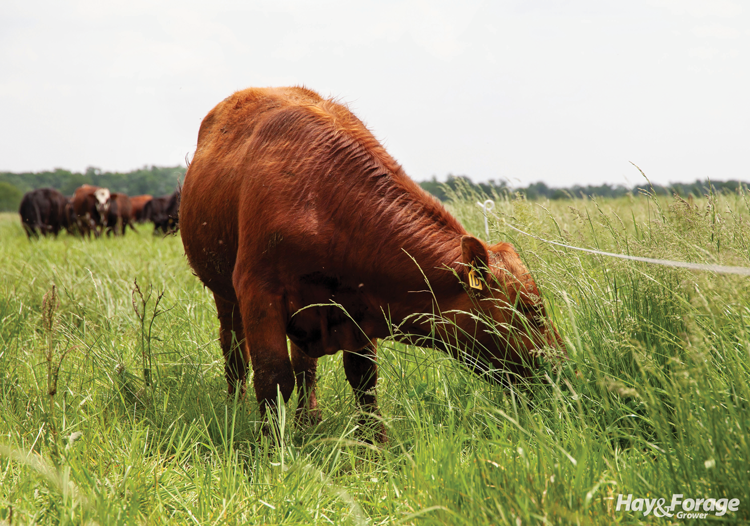
"Should I shred my pastures?” This is a question asked by many beef cattle and forage producers. To answer this, one must consider the potential impacts of shredding pastures on animal performance, forage quality, forage yield, weed control, and any other factors specific to the situation.
While shredding immediately improves pastures visually, it is generally not extremely effective from a weed or brush control standpoint. Shredding may kill some annual weeds, but the damage from those weeds was likely already done. They will be dying at the end of the growing season anyway. Moreover, the efficacy of shredding pastures to control perennial weeds and most brush species is generally even less.
From a forage yield perspective, the appropriate use of herbicides is more advantageous than shredding pastures. Weeds reduce forage yield by competing with desirable plant species for water, sunlight, and plant nutrients; however, herbicides kill weeds when they are small. This greatly minimizes the impact of weeds on forage yield. Additionally, herbicides with residual activity can continue to kill new weeds as they germinate. Shredding only cuts off the top portion of the weeds that are currently growing in the pasture and has no effect on the weeds that are below the blade height or weeds that will germinate in the near future.
Shredding also has a direct negative effect on forage yield. Some forage is lost when pastures are shredded, but the amount of lost forage will vary depending on the height at which plants are shredded, the primary forage species, and the amount of forage currently in the field. If there is a large amount of cut forage left in the field after shredding, it can slow plant regrowth by blocking sunlight.
From a forage quality standpoint, consider how forage quality changes throughout the canopy from the top to the bottom. The newest growth will be the highest quality forage. For most grass species, the majority of this new growth is found in the top one-third of the canopy.
For instance, take an actively growing bermudagrass stand with a canopy height of 12 inches. The highest quality forage would be found in the top one-third of the canopy, whereas the oldest growth and lowest quality forage is in the bottom one-third of the canopy. The forage in the middle third of the canopy would be intermediate in quality to the top and bottom. If this field were shredded to a height of 6 inches, then all the best quality forage and half of the intermediate quality forage would be removed. This would leave less, lower quality forage for cattle to graze until sufficient regrowth has occurred. During this time, animal performance would be reduced.
Some shredding exceptions
Shredding might be necessary in some situations. Selective shredding may provide better access to recreational areas. Shredding might also be desirable to keep grass shorter around buildings or other structures for safety reasons. If pastures or hayfields are surrounded by highly sensitive plants or located near neighborhoods, then shredding may be desired over the use of herbicides. In these scenarios, the alternative benefit would be prioritized over cost, forage production, or forage quality considerations.
Another situation when shredding might prove beneficial is if there is a tremendous amount of dormant forage or weeds that are preventing active growth of the other species. In this case, shredding will only be worthwhile if it stimulates new growth of the desired forage. The most practical use of this approach is in fields that have not been hayed or grazed for a year or more.
The time requirements and cost of shredding compared to using herbicides for weed control vary. At 3 miles per hour (mph), a 12-foot shredder could cover 4.36 acres per hour. At the same 3 mph, a sprayer with an effective spray width of 28 feet could cover 10.18 acres per hour. To shred a 100-acre pasture, it would take almost 23 hours, but that same field could be sprayed in about 10 hours.
In most situations, sprayers can operate at faster speeds than shredders. If the 100-acre field were sprayed at 5 mph, it could be covered in about six hours. Therefore, spraying would save a tremendous amount of time and diesel fuel compared to shredding. The tractor would also be operated at lower revolutions per minute (rpm) for spraying compared to shredding, saving even more diesel.
For a full economic comparison, the cost of the sprayer, shredder, and herbicide products would need to be considered. In most cases, the cost of the sprayer and herbicide will be less than the shredder, especially when the added diesel and labor are accounted for.
So, that brings us back to the original question: Should I shred my pastures? Shredding is not advantageous if enhancing animal performance, weed control, or forage yield is the focus. However, it may be the solution in some cases for safety or aesthetic purposes.
This article appeared in the March 2024 issue of Hay & Forage Grower on page 25.
Not a subscriber? Click to get the print magazine.

